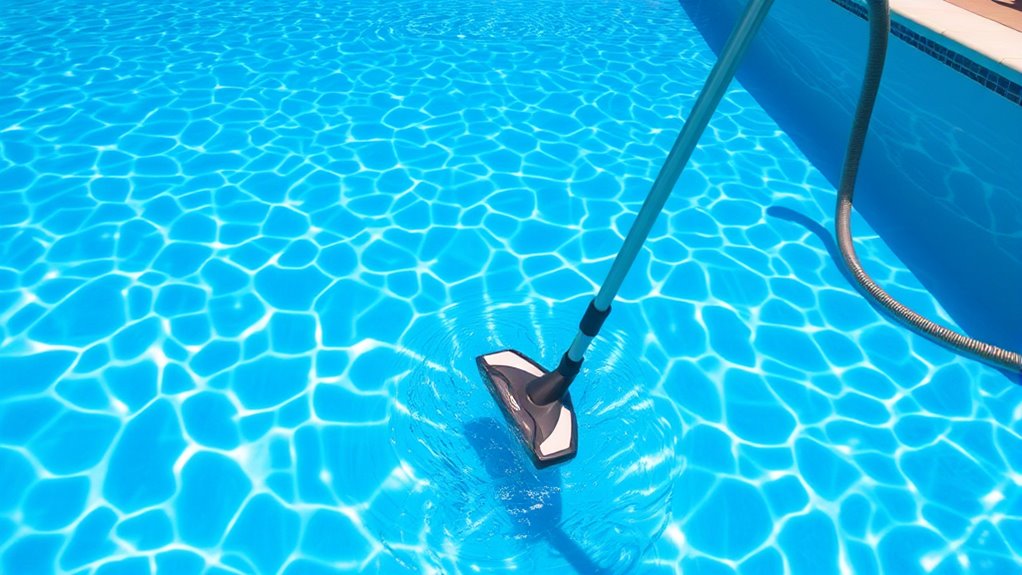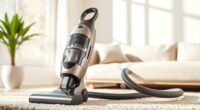To vacuum your pool properly, gather your tools like a pool vacuum, hose, and telescoping pole, then prepare the water level for effective suction. Connect the vacuum securely, prime it by filling the head with water, and turn on the pump to create suction. Use smooth, overlapping strokes, especially in corners and hard-to-reach spots, moving from deep to shallow areas. For more expert tips, keep exploring how to achieve that sparkling clean swim you’re after.
Key Takeaways
- Gather and check all necessary tools, including a vacuum, hose, telescoping pole, and debris filters, before starting.
- Properly connect and prime the vacuum, ensuring secure fittings and removing air bubbles for strong suction.
- Adjust water levels to the optimal height for effective vacuuming and filter operation.
- Vacuum from the deep end to shallow, using slow, overlapping strokes for thorough debris removal.
- Rinse and dry equipment after use, then store in a dry, shaded area to prolong its lifespan.
Gather the Necessary Tools and Equipment
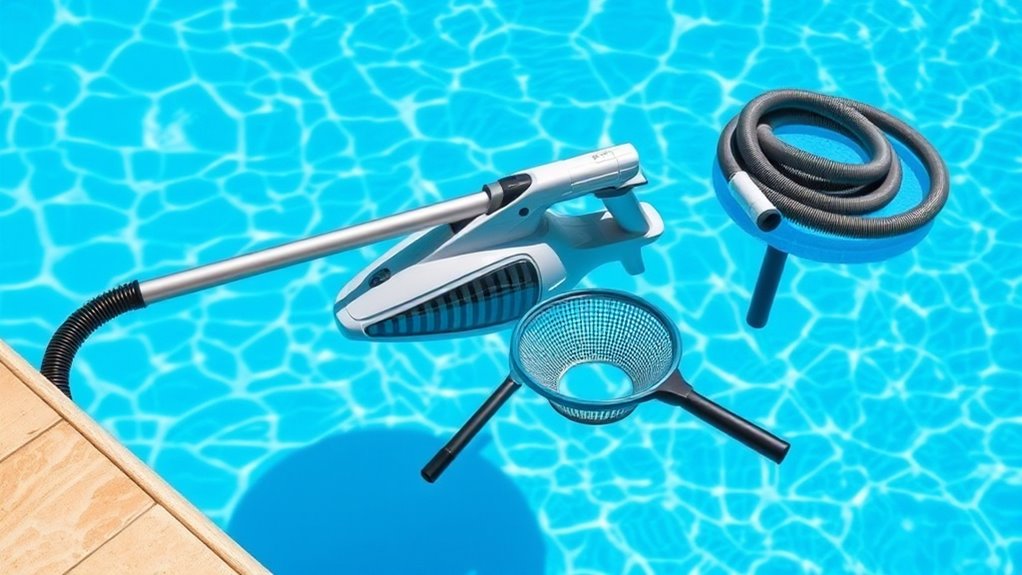
Before you begin vacuuming your pool, it’s important to gather all the necessary tools and equipment. You’ll need a pool vacuum, either manual or robotic, along with a telescoping pole and a hose if applicable. Make sure you have the right filter bag or cartridge to catch debris. Check that your pool chemicals are balanced before starting to prevent algae growth or cloudiness. Safety precautions are essential—wear goggles and gloves to protect your eyes and skin from chemicals and debris. Confirm the power supply is secure if using an electric vacuum. Having everything ready not only makes the process smoother but also helps you work efficiently while maintaining a safe environment throughout your cleaning routine. Additionally, understanding your vacuum’s performance metrics can help you select the most effective equipment for your pool size and debris type. Regular maintenance of your equipment ensures consistent cleaning efficiency and prolongs its lifespan. Being familiar with filter types can further optimize your cleaning process and prevent clogging. To ensure optimal results, consider reviewing filter maintenance procedures regularly to keep your system functioning at its best.
Prepare Your Pool for Vacuuming

Before you start vacuuming, make sure to clear away any debris from the pool’s surface. Next, check and adjust the water level so it’s at the proper height for effective cleaning. Taking these steps guarantees your vacuum works efficiently and leaves your pool sparkling. Additionally, ensuring the water has the correct water level can help optimize the vacuum’s performance. Proper automation in pool maintenance can further streamline your cleaning process and maintain clarity over time. Incorporating water conservation techniques into your routine can also enhance sustainability and reduce ongoing costs, leading to a cleaner swimming environment.
Clear Debris First
Have you ever tried vacuuming your pool only to find the debris just keeps clogging your filter or floating right back up? Before you start, it’s essential to clear the surface and bottom of any loose debris. This step guarantees better pool safety, preventing debris from clogging your vacuum or filter system. Use a leaf skimmer or a brush to remove leaves, twigs, and dirt that have settled at the bottom or float on the surface. Removing debris first reduces strain on your equipment and makes the vacuum more effective. Keep in mind, a clean pool surface also minimizes the risk of clogging and damage to your filter, helping you maintain a safe swimming environment. Proper debris removal is key to a smooth, efficient vacuuming process. Additionally, ensuring your pool has good lighting can help you better see debris and optimize your cleaning efforts. Regular maintenance, including pool tuning, can further improve filtering efficiency and prolong the life of your equipment. Incorporating advanced filtration systems can also enhance debris removal and keep your pool sparkling clean. Being aware of local store hours can also be helpful if you need to purchase supplies or equipment last-minute. Moreover, understanding the Power of Imagination can inspire creative solutions to common pool maintenance challenges and improve your overall approach to pool care.
Adjust Water Level
After removing surface and bottom debris, check your pool’s water level to guarantee it’s properly adjusted for vacuuming. An ideal water level ensures effective skimmer operation and prevents the vacuum from losing suction. If the water is too low, the skimmer won’t function properly; if it’s too high, debris can bypass the filter. Use this table to visualize the ideal water level:
| Water Level | Effect on Skimmer Operation |
|---|---|
| Correct Level | Skimmer works efficiently, debris is trapped |
| Too Low | Skimmer can’t draw water effectively |
| Too High | Debris slips past skimmer, reduces suction |
Adjust the water level by adding or removing water to maintain the proper height before you start vacuuming. Regularly assessing and maintaining proper water levels can help prevent issues and ensure optimal pool cleanliness. Proper water level management is essential for effective skimmer operation and can prevent strain on your pool’s filtration system. For pools with an electric dirt or pool vacuum, ensure the water level supports optimal suction power and prevents strain on the equipment.
Choose the Right Vacuum Type for Your Pool

Choosing the right vacuum for your pool depends on several factors, including the size of your pool, the type of debris you typically encounter, and your budget. If you have a large pool with heavy debris, an automatic cleaner can save you time and effort by handling most of the work itself. These cleaners come in robotic, suction, and pressure models, each suited for different needs. On the other hand, if your pool is small or has light debris, a manual vacuum might be more cost-effective and give you more control. Manual vacuums require you to move them around, but they are straightforward and easy to operate. Assess your pool’s size and debris level to determine which type of vacuum best fits your cleaning routine.
Connect the Vacuum to Your Pool’s Filtration System
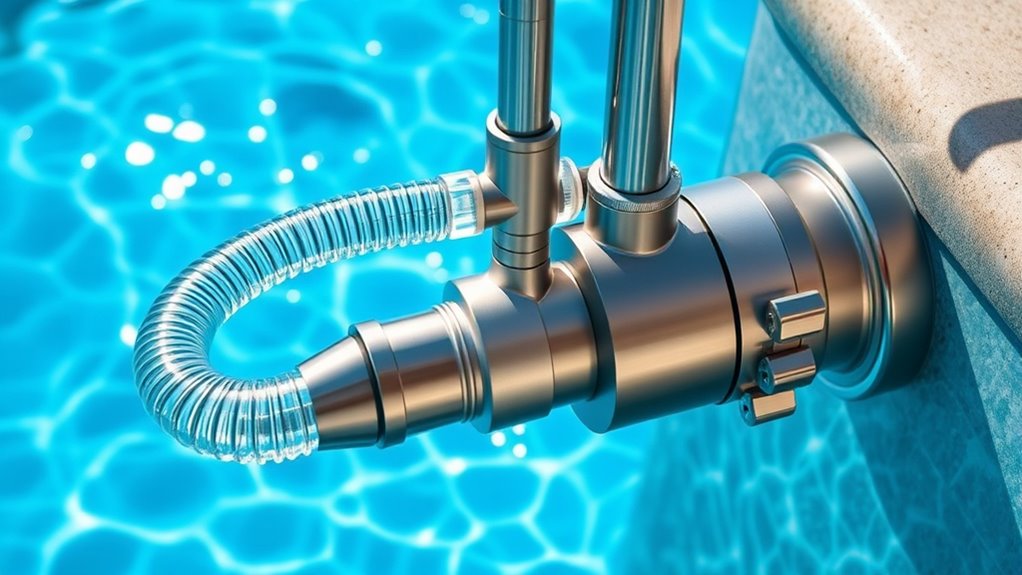
Connecting your pool vacuum to the filtration system is a straightforward process that guarantees efficient cleaning. First, verify your filtration system is turned off to prevent debris from entering the pump. Attach the vacuum head to the telescopic pole, then connect the hose to the vacuum and the skimmer or dedicated vacuum port. As you connect the hose, make sure it’s secure and free of air pockets, which can hinder suction. Once everything is in place, turn on the filtration system. This setup allows your pool’s filtration system to create the necessary suction, making your vacuum work effectively. Properly connecting your vacuum to the filtration system is essential for smooth pool maintenance, helping you achieve a clean, sparkling pool with less effort.
Prime the Vacuum to Ensure Proper Suction
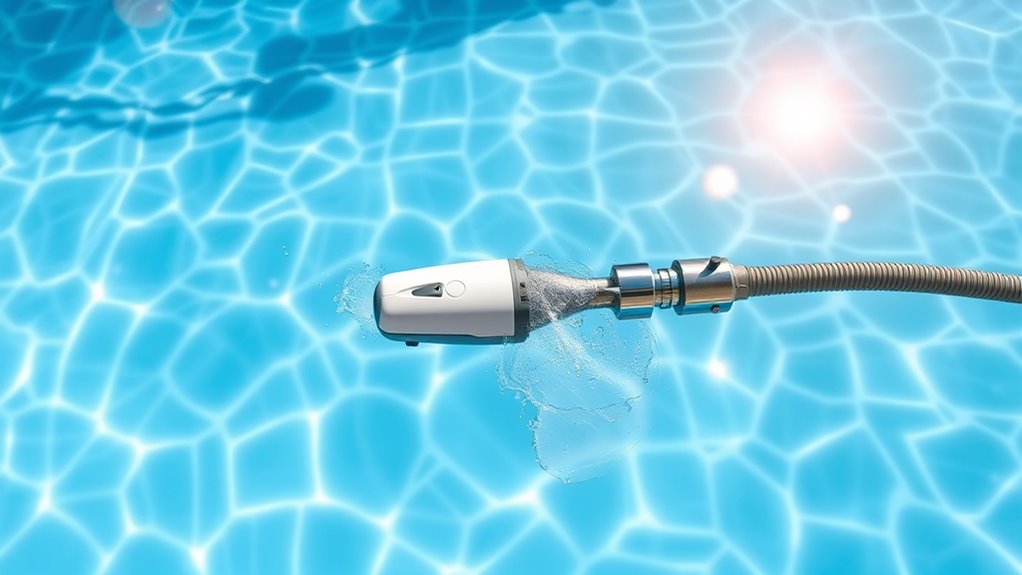
Before you start vacuuming, make sure the vacuum connection is secure and free of leaks. Remove any air bubbles from the hose or pump to prevent loss of suction. Then, fill the vacuum head with water to prime it and guarantee steady, effective suction.
Check Vacuum Connection
To guarantee your pool vacuum works efficiently, you need to prime the vacuum to achieve proper suction. Start by checking your vacuum connection to ensure it’s secure and free of leaks. A loose or faulty connection can cause loss of suction, making cleaning ineffective. Carefully examine the vacuum hose, skimmer, and pump fittings for any cracks or loose fittings. If you experience connection troubleshooting issues, reattach all parts firmly, ensuring they’re snug.
- Confirm the hose is attached tightly to the skimmer and vacuum head
- Look for cracks or damage in the hose or fittings
- Make sure the vacuum head is securely connected to the hose
- Ensure the connection points are free of debris or obstructions
Taking these steps will help maintain a strong vacuum connection for optimal cleaning performance.
Remove Air Bubbles
Air bubbles can disrupt the vacuum’s suction, so it’s essential to eliminate them to guarantee effective cleaning. When air bubbles are present, they reduce vacuum efficiency, making it harder to pick up debris. To remove air bubbles, ensure the vacuum hose is fully submerged in water and fill the vacuum head completely before connecting. Check for leaks or loose fittings that might let air in. Visualize the process with this table:
| Step | Action | Result |
|---|---|---|
| Submerge hose | Fill with water before connecting | Eliminates air pockets |
| Secure fittings | Tighten all connections | Prevents air leaks |
| Check for leaks | Inspect hose and fittings | Maintains proper suction |
| Remove air bubbles | Squeeze hose gently or re-prime | Improves vacuum efficiency |
Following these steps guarantees a bubble-free start for a cleaner pool.
Prime With Water
Have you ever noticed your pool vacuum losing suction and not cleaning effectively? To fix this, you need to prime your vacuum with water. Proper priming guarantees strong suction and smooth vacuum maintenance. Start by submerging the vacuum head and hose completely underwater, removing any air pockets. This step is vital because air can disrupt the pool chemistry balance and reduce cleaning efficiency.
Remember these tips:
- Fill the hose with water before connecting it to the skimmer or pump.
- Ensure all connections are airtight.
- Check for leaks or cracks in the hose.
- Keep the vacuum head submerged to prevent air from entering.
Priming with water helps maintain ideal pool chemistry and keeps your vacuum working at its best. It’s a simple step that prevents suction issues and prolongs your equipment’s lifespan.
Start Vacuuming From the Deep End Toward the Skimmer
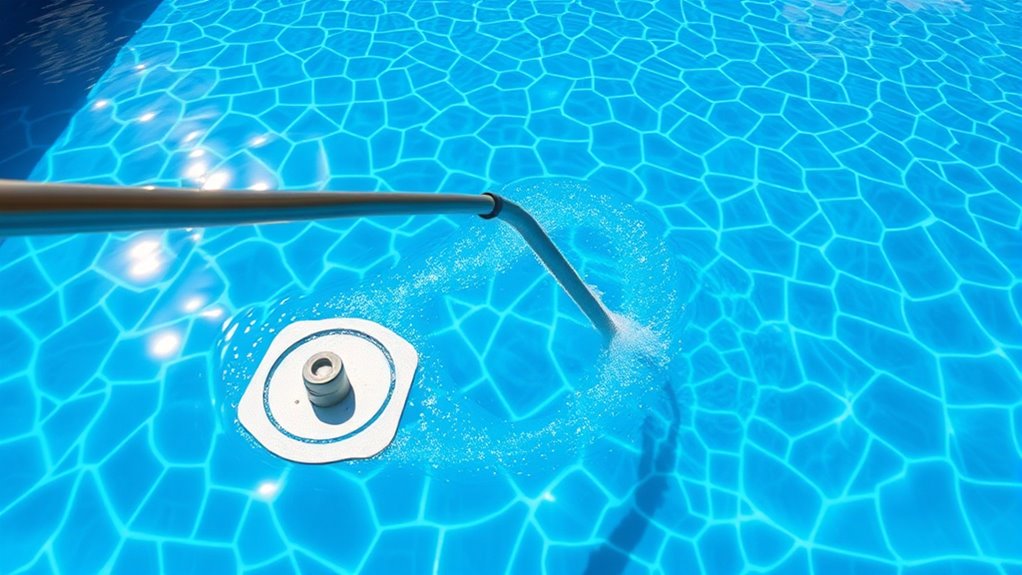
Starting your vacuuming from the deep end of the pool guarantees debris is drawn toward the skimmer effectively. This approach prevents loose pool debris from settling in hard-to-reach areas, making vacuum maintenance more efficient. As you move from the deep end towards the skimmer, you ensure that dirt and debris are directed toward the filter system, reducing the chance of redistributing particles. Begin at the deepest point, slowly guiding the vacuum head along the floor in overlapping strokes. This technique helps lift dirt from the bottom and keeps the debris moving toward the skimmer. Consistently starting at the deep end ensures you cover the entire pool thoroughly and maintain a clean, inviting swimming environment.
Use Smooth, Overlapping Movements for Effective Cleaning
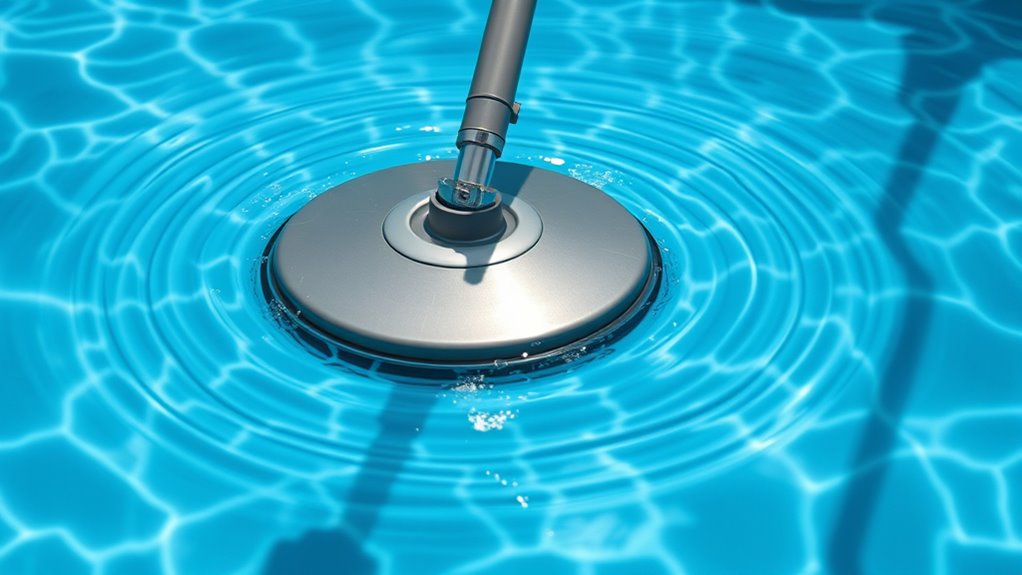
To clean your pool effectively, use smooth, overlapping movements with your vacuum head. This technique guarantees thorough coverage and prevents missed spots. Maintain steady, consistent patterns to maximize debris pickup and reduce streaks or uneven cleaning. Focus on creating a fluid motion that overlaps slightly with each pass, which helps lift dirt from the pool surface or floor.
Use smooth, overlapping motions to ensure thorough, even pool cleaning and debris removal.
Here are some key tips:
- Use gentle yet firm pressure to avoid damaging the vacuum head.
- Follow consistent, overlapping patterns for complete coverage.
- Move slowly to give the vacuum time to pick up debris effectively.
- Change directions frequently to prevent missed areas.
Pay Attention to Corners and Hard-to-Reach Areas
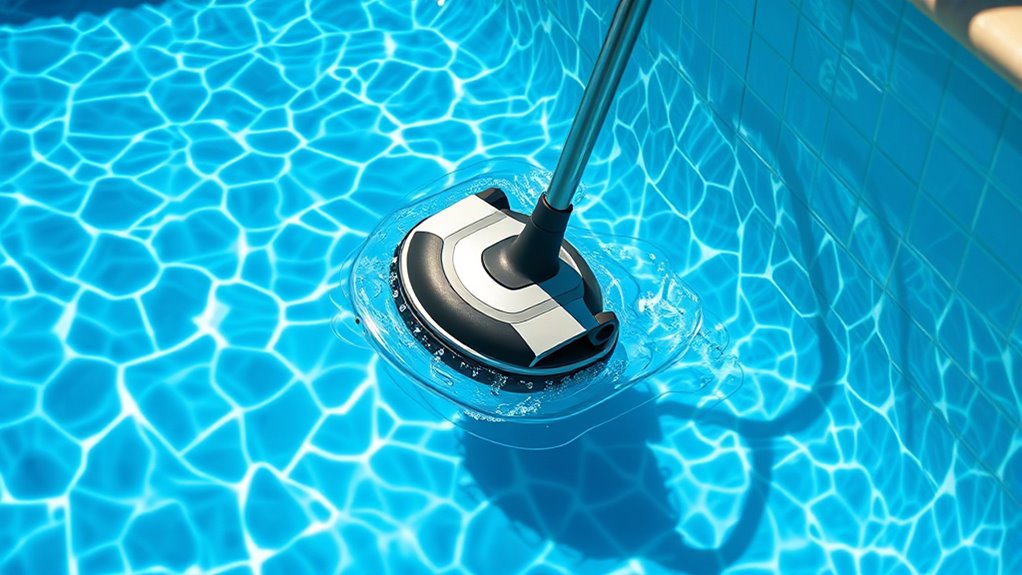
Corners and hard-to-reach areas often trap debris that can be missed during general cleaning. To guarantee a thorough vacuum, focus on corner cleaning by directing your vacuum head into each corner, moving slowly to loosen debris. Don’t neglect the wall edges or tight spots where debris tends to accumulate. For hard-to-reach areas, use a flexible hose or extend your vacuum’s wand to access tricky spots. Pay attention to the corners where walls meet the pool floor, as debris can settle there unnoticed. By spending extra time on these areas, you prevent build-up that can lead to algae or cloudy water. Properly addressing corners and hard-to-reach spots guarantees a more complete clean and keeps your pool sparkling.
Monitor the Vacuum’s Performance and Adjust as Needed
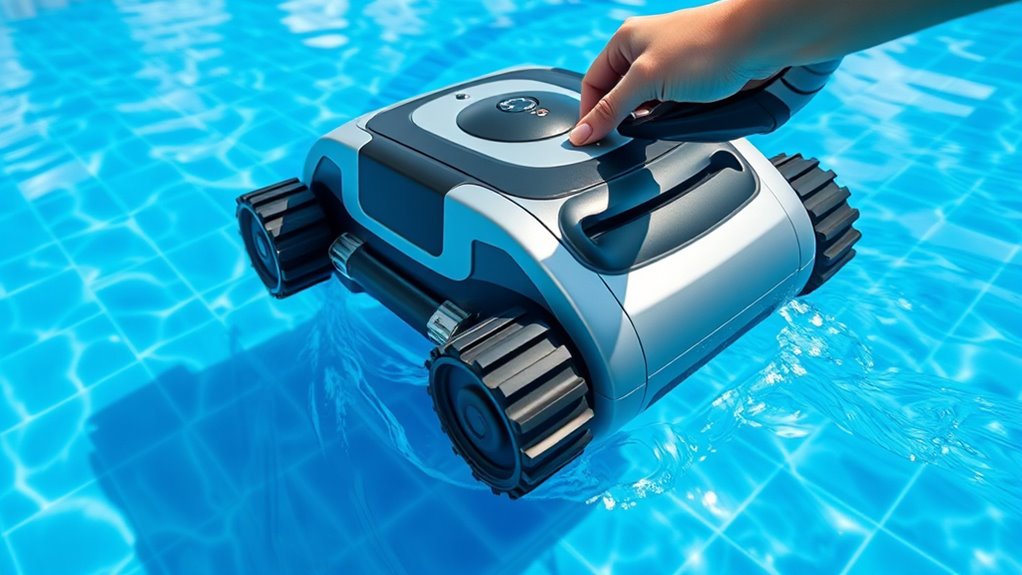
As you vacuum your pool, it’s important to regularly monitor the vacuum’s performance to guarantee it’s cleaning effectively. Keep an eye on how well it’s picking up debris and whether it’s moving smoothly across the pool surface. If you notice poor suction or uneven cleaning, it’s time for some vacuum maintenance. Performance monitoring helps prevent issues before they worsen. To optimize your vacuuming, consider these tips:
- Check for clogs or blockages in the hose
- Ensure the vacuum’s brushes are in good condition
- Verify the pump pressure is within recommended levels
- Adjust the vacuum’s steering to cover missed spots
Consistent performance monitoring allows you to make quick adjustments, ensuring your pool stays spotless and your equipment lasts longer.
Clean and Store Your Equipment After Vacuuming
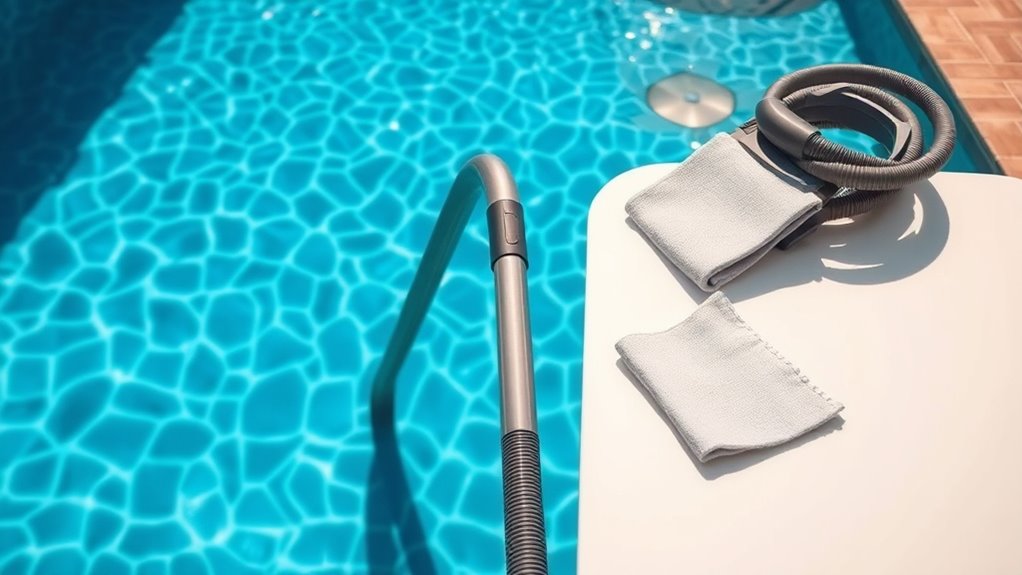
After vacuuming your pool, it’s important to clean your equipment thoroughly with water to remove any debris. Make sure to dry everything completely before storing to prevent mold or damage. Store your tools in a dry, cool place to keep them in good condition for next time.
Rinse Equipment Thoroughly
Once you’ve finished vacuuming your pool, it’s important to rinse your equipment thoroughly to remove any dirt, debris, or chemical residue. Proper rinsing helps maintain equipment maintenance and supports the chemical balance of your pool. To do this effectively:
- Use clean water to wash all hoses, brushes, and the vacuum head.
- Check for any remaining debris or buildup and remove it.
- Inspect the equipment for signs of damage or wear.
- Store everything in a dry, cool place to prevent mold or corrosion.
Rinsing ensures your equipment stays in good condition and prevents issues that could affect your pool’s chemical balance. Taking these steps keeps your vacuuming routine efficient and prolongs the life of your tools, helping you enjoy a sparkling, clean pool all season.
Dry Completely Before Storing
To prevent mold, rust, and corrosion, it’s essential to guarantee your equipment is completely dry before storing it. Proper drying is a key part of equipment maintenance and ensures your tools stay in good condition for future use. After vacuuming, wipe down your pool vacuum, hoses, and brushes with a dry cloth to remove any remaining water. Pay special attention to crevices and connections where moisture can hide. Avoid storing wet equipment, as it can lead to mold growth and deterioration over time. Dry storage helps extend the lifespan of your tools and keeps them ready for your next cleaning session. Taking a few extra minutes to dry everything thoroughly now saves you time and money in repairs or replacements later.
Store in Dry, Cool Place
Storing your pool equipment in a dry, cool place helps prevent damage from moisture and temperature fluctuations. After vacuuming, guarantee all parts are thoroughly dry before storing. Proper storage protects your equipment from rust, mold, and deterioration, especially if you’ve used pool chemicals during cleaning. Keep your vacuum, hoses, and brushes in a well-ventilated area away from direct sunlight. Avoid storing equipment near pool covers or chemicals that could cause corrosion or degradation. To maintain your gear’s longevity, consider these tips:
- Store in a shaded, dry spot
- Keep away from pool chemicals and pool covers
- Use sealed containers for smaller parts
- Ensure everything is completely dry before storage
This approach preserves your equipment’s effectiveness and ensures it’s ready for your next pool cleaning.
Frequently Asked Questions
How Often Should I Vacuum My Pool for Optimal Cleanliness?
You should vacuum your pool at least once a week for ideal cleanliness, especially during peak swimming season. Regular vacuuming is essential for effective pool maintenance and helps prevent debris buildup. If you notice more dirt or leaves, increase your vacuuming schedule accordingly. Consistent maintenance keeps your pool pristine and reduces the need for extensive cleaning later. Stick to this routine, and you’ll enjoy a sparkling, inviting swim every time.
Can I Vacuum My Pool Without Turning off the Pump?
Imagine your pool as a mirror, reflecting clarity and cleanliness. You can vacuum without turning off the pump, but it’s best to turn it off first to protect your pool chemicals and vacuum accessories. Running the pump while vacuuming might stir debris and disrupt chemical balance. Turn off the pump, then vacuum carefully to keep your pool sparkling, ensuring your pool chemicals stay balanced and your vacuum accessories last longer.
What Safety Precautions Should I Take During Vacuuming?
During vacuuming, guarantee pool safety by unplugging the vacuum when not in use and avoiding water contact with electrical components. Handle equipment carefully to prevent damage or injury, and always follow manufacturer instructions. Keep children and pets away to avoid accidents, and check that the pool’s pump and filter are functioning properly. Wearing gloves and goggles can protect you from debris and chemicals. Prioritize safety to enjoy a clean, safe swimming environment.
How Do I Prevent the Vacuum From Getting Stuck or Lost?
Imagine your vacuum hose as a guiding river, flowing smoothly through your pool. To prevent it from getting stuck or lost, you need proper vacuum hose management—keep the hose free of tangles and secure it to prevent float-away. Adjust the float valve to ensure consistent suction, avoiding sudden stops or disconnections. Regularly check for kinks or obstructions, and move the vacuum slowly to maintain a steady, uninterrupted cleaning flow.
Is It Necessary to Backwash or Clean the Filter After Vacuuming?
After vacuuming, you should definitely backwash or clean your filter to guarantee proper filter maintenance and debris removal. This step helps remove any dirt or debris collected during vacuuming, preventing clogs and maintaining ideal water flow. Regular filter cleaning keeps your pool water crystal clear and ensures your filtration system works efficiently. So, don’t skip this important step—it’s key to keeping your pool sparkling clean and ready for swimming.
Conclusion
Remember, a clean pool is a happy pool. Stay patient and methodical as you vacuum, paying attention to every corner. With the right tools and techniques, you’ll keep your pool sparkling all season long. Don’t forget, Rome wasn’t built in a day—neither is a perfect pool. Keep at it, and you’ll enjoy crystal-clear water that invites you in whenever you want to swim. Happy cleaning!
